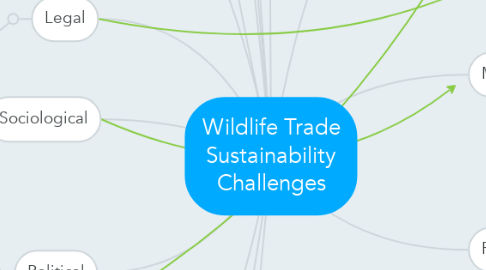Wildlife Trade Sustainability Challenges
by Guy Burger


1. Weaknesses within the current structure
1.1. No feeling of ownership/responsibility among locals
1.2. Lack of opportunity for people outside of WLT
1.3. Corruption
1.3.1. Increased difficulty in funding and implimentation
2. Strengths within the current structure
2.1. Cultural shift
2.2. Legal framework
2.2.1. CITES
2.2.1.1. 1975-Now
2.2.1.2. Protocol for good trade
2.2.1.3. 5600 sp animal
2.2.1.4. 30000 sp plant
2.3. Sustainable models?
2.4. Cultural shifts
2.4.1. Where?
2.5. Technology
2.5.1. Tech and enforcement
3. Trade of animal parts/ animals
3.1. Parts which can be harvested without harm eg Rhino horn
3.1.1. Parts removed therefore risk of hunting averted
4. Political
4.1. A lack of nationally implemented solutions and a reliance on international bodies
4.2. The increase of poaching through war and conflict
4.2.1. Difficulties of enforcement
4.2.2. Money used to sustain conflict
4.2.2.1. People as well as animals suffer
4.3. Power and money of the wildlife trade organisations
4.3.1. Vested interests of powerful people
5. Sociological
5.1. Influence of poverty/ pressure of
6. Legal
6.1. Complete ban
7. economical
7.1. Demand
7.1.1. Western and EU
7.1.1.1. Reasons for demand?
7.1.2. Eastern esp China
7.2. Protocol for good trade
8. Primary challenges of making wildlife sustainable
8.1. Changing behaviour
8.2. Creating sustainable WLT
8.2.1. Regulated trade
8.2.1.1. Quotas
8.2.2. Legalised elements
8.3. Sensible outcome based legislation
9. How do we reduce demand?
9.1. Technology
9.1.1. Replace products
9.1.2. Media influence
9.1.2.1. Cultural change/ mindset change
9.1.2.1.1. Examples?
9.2. Farming
9.2.1. Replace products
10. Issues with legal wildlife trade
10.1. Legitimises trade in wildlife
10.2. Money/ markets
11. Issues with Illegal wildlife trade
11.1. Loss of wildlife
11.2. Black market
11.2.1. Connected to other illegal activities
11.3. Uncontrollable
11.3.1. Obscured from view
